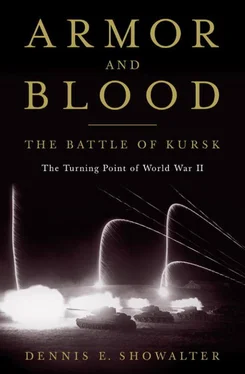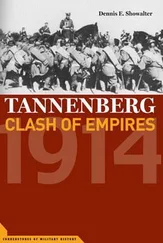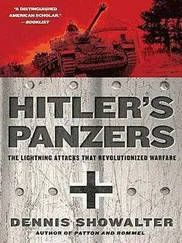15 Unexpectedly successful advanceLodieu, III. Pz. Korps , pp. 115–116; Zamulin, Demolishing the Myth , p. 406.
16 Stalin … issued orders to Steppe FrontZamulin, Demolishing the Myth , pp. 409–410.
17 About two hundred tanksIbid., p. 410.
18 Dispatch a strong forceIbid., p. 413.
19 Trufanov’s fire brigade arrived in incrementsIbid., pp. 419–423.
20 “Introduce the strictest discipline”Ibid., pp. 425, 486–487. An English translation of the “Order for the National Commissar for the Defense of the Soviet Union, July 28, 1942” is accessible on the Internet at http://www.stalingrad-info.comand independently under “Order 227.”
21 Vasilevsky informed StalinZamulin, Demolishing the Myth , p. 426.
22 Providing the muscle for the straight right-hand punchIbid., pp. 204–205.
23 Grossdeutschland’s sideways shuffleFor the confusing events of July 12 in this sector, cf. “KTB: Darstellung der Erignsse XLVIII Panzer-Korps am 12.7.1943,” National Archives, T-314, roll 1170; “XLVIII Panzerkorps Tagesmeldungen an Pz.AOK, 12.7.1943,” National Archives, T-314, roll 1171; the published material in Spaeter, Grossdeutschland , pp. 129–130; Mellenthin, Panzer Battles , 224; Glantz and House, Battle of Kursk , pp. 202–208; and Nipe, Blood, Steel, and Myth , pp. 351–353.
24 The corps commander failedZamulin, Demolishing the Myth , pp. 430–431.
25 “Temporarily compelled … to withdraw”Spaeter, Grossdeutschland , p. 130; Zamulin, Demolishing the Myth , pp. 432–434.
26 He could no longer advanceZamulin, Demolishing the Myth , pp. 430, 434.
27 More cobbler than blacksmithCf. Armstrong, Red Army Tank Commanders , pp. 94–95.
28 Shifting to a defensive postureSpaeter, Grossdeutschland , p. 130.
29 Manstein appeared at corps headquartersNipe, Blood, Steel, and Myth , p. 353.
30 Knobelsdorff’s eventual ordersIbid., p. 353; Mellenthin, Panzer Battles , pp. 126–128.
31 Swan song of the panzersIvan S. Konev, Aufzeichnungen eines Frontoberbefehlshabers 1943/44 , trans. Irmgard Zeisler, 2nd ed. (Berlin: Militärverlag der DDR, 1983), p. 43.
32 Leibstandarte and Das Reich were kept awakeNipe, Blood, Steel, and Myth , pp. 315–317.
33 Rotmistrov’s tankers were no less nervousCf. the accounts in Zamulin, Demolishing the Myth , p. 298, and Lloyd Clark, The Battle of the Tanks: Kursk, 1943 (New York: Atlantic Monthly Press, 2011), pp. 314–315. Porter, Fifth Guards Tank Army , p. 56, refers to the hatch problem.
34 Not all the Russian tankers … were menAnna Krylova, Soviet Women in Combat: A History of Violence on the Eastern Front (New York: Cambridge University Press, 2010), brilliantly contextualizes the general subject.
35 Rotmistrov arrived at the command postZamulin, Demolishing the Myth , p. 299.
36 Caught in their blanketsRibbentrop’s narrative begins in Kurowski, Panzer Aces , pp. 174–178.
37 Only seven tanks that morning“KTB 4th Panzerarmee, Chefnotizen für 12.7.1943,” National Archives T-313, reel 369.
38 Soviet barrage was falling shortZamulin, Demolishing the Myth , pp. 284–385, 301–306.
39 Fifth Guards Tank Army’s first battleIbid., pp. 306–307.
40 “Steel! Steel! Steel!”Ibid., pp. 308–309. Though Zamulin deftly corrects the details of Rotmistrov’s colorful, frequently cited account of the jump-off, its ambience remains.
41 A massive air attackBergström, Kursk: The Air Battle , pp. 79–81.
42 None was better than Hans-Ulrich RudelHans-Ulrich Rudel, Stuka Pilot , trans. Lynton Hudson (New York: Ballantine Books, 1958), pp. 85–86. Bergström, Kursk: The Air Battle , p. 79, establishes July 12, rather than the more generally cited July 5, as the most likely date for this.
43 “The first flight flies behind me”Rudel, Stuka Pilot , p. 85.
44 “It was like a giant had grabbed”Interview quoted in Clark, Battle of the Tanks , p. 345.
45 Russians were advancing almost blindlyAn easily accessible overview of the technical and operational capacities of the T-34/76 at this period is Robert K. Forczyk, Panther vs T-34: Ukraine 1943 (Oxford: Osprey Publishing, 2007).
46 Puts 234 tanks in the first attack waveZamulin, Demolishing the Myth , pp. 309–310.
47 “The field … sprang to life”Ibid., p. 321.
48 “Alone at Prokhorovka”His actual title is “Born Again at Prokhorowka.” Kurowski, Panzer Aces , pp. 178–180.
49 No knowledge of its presenceZamulin, Demolishing the Myth , pp. 327–328.
50 “Inferno of fire, smoke, burning T-34s”Kurowski, Panzer Aces , p. 181.
51 Command and control erodedZamulin, Demolishing the Myth , pp. 319–320.
52 Some of Citadel’s fiercest fightingIbid., pp. 315–328 passim.
53 Personally took out a T-34Patrick Agte, Jochen Peiper: Commander, Panzerregiment Leibstandarte , trans. Robert Dohrenwend (Winnipeg: J. J. Fedorowicz, 1999), p. 176.
54 Situational awareness and a cool headPatrick Agte, Michael Wittmann and the Waffen SS Tiger Commanders of the Leibstandarte in WWII , vol. 1. (Mechanicsburg, PA: Stackpole Books, 2006), specifically pp. 85–132 passim, contextualizes Wittmann’s Citadel experience with a minimum of the Waffen-SS-flavored heroic pathos common in this genre. T-shirts celebrating Wittmann are nevertheless available at a number of commercial and commemorative Internet sites.
55 Halt at an angleNipe, Blood, Steel, and Myth , p. 330.
56 Citadel’s defining incidentZamulin, Demolishing the Myth , pp. 352–353; Kurowski, Panzer Aces , p. 205.
57 The still-desperate meleeNipe, Blood, Steel, and Myth , p. 332; Agte, Jochen Peiper , p. 176.
58 Ran full tilt intoZamulin, Demolishing the Myth , pp. 332–334; Lehmann, Leibstandarte , pp. 234–235.
59 A veteran of the 10th Tank Corps … wroteQuoted in Zamulin, Demolishing the Myth , p. 335.
60 Ramming a German AFVIbid., p. 333.
61 The relationship of myth and reality was closerIbid., pp. 364–370; Nipe, Blood, Steel, and Myth , pp. 340–343.
62 Improvised company of captured T-34sWeidinger, Das Reich , pp. 199–200.
63 Rotmistrov arrivedZamulin, Demolishing the Myth , pp. 377–378, 456–457.
64 Heavily contingent on Totenkopf’s performanceNipe, Blood, Steel, and Myth , pp. 343–349, 381–398.
65 Not all the comrades were valiantIbid., pp. 356, 389–90. Paul Wanke, Russian/Soviet Military Psychiatry, 1904–1945 (London: Routledge, 2012), surveys the USSR’s approach to psychiatric casualties.
Читать дальше












